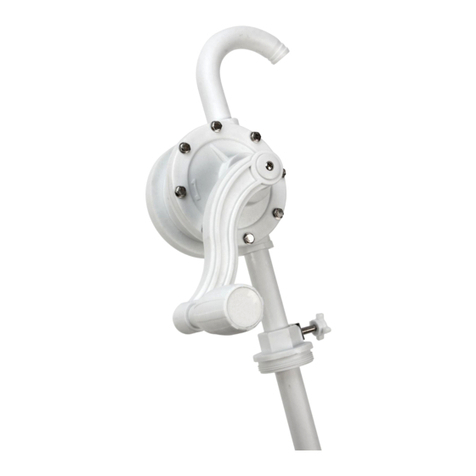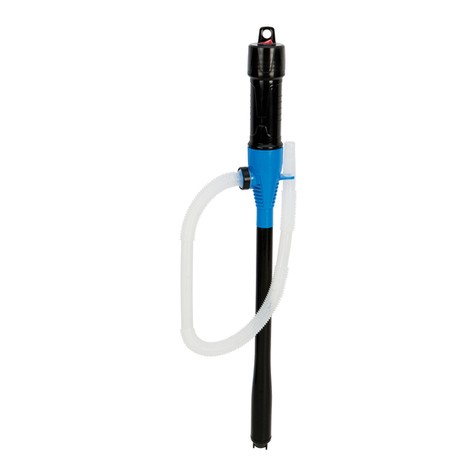
4 5
Figure A
TO WHEEL CALIPER
BLEEDER SCREW
• Maintain a safe working environment. Keep the work area well lit. Make sure there is
adequate surrounding workspace. Always keep the work area free of obstructions,
grease, oil, trash, and other debris. Do not use the Brake Bleeder/Vacuum Pump in
areas near flammable chemicals, dusts, and vapors. Do not use this product in a damp
or wet location.
• Maintain labels and nameplates on this product. These carry important information. If
unreadable or missing, contact Performance Tool for a replacement.
•
Keep the Handles of the Brake Bleeder dry, clean, and free from brake fluid, oil, and grease.
• Prior to using the Brake Bleeder/Vacuum Pump make sure to read and understand all
warnings, safety precautions, and instructions as outlined in the vehicle manufacturer’s
instruction manual. Every vehicle has specific measurement values for vacuum related
readings. It is beyond the scope of this manual to properly describe the correct
procedure and test data for each vehicle.
WARNING:
Carbon monoxide is produced while a vehicle’s engine is operating and is
deadly in a closed environment. Early signs of carbon monoxide poisoning resemble the
flu, with headaches, dizziness, or nausea. If you have these signs, the work area may not
be vented properly. Get fresh air immediately.
• Prior to using the Brake Bleeder/Vacuum Pump, make sure to place the vehicle’s
transmission in “PARK” (if automatic) or “NEUTRAL” (if manual). Then, block the tires
with chocks.
• Be alert for hot engine parts to avoid accidental burns.
• Avoid accidental fire and/or explosion. Do not smoke near engine fuel and battery
components.
• Use the Brake Bleeder only with brake fluid. Do not attempt to use the tool to siphon
any other liquids. Damage to the internal chamber and seal, or future brake fluid
contamination ma result.
• Follow guidelines for proper brake fluid disposal. Used brake fluid should be removed
from the vehicle and properly recycled. Many states require recycling. Contact your local
solid/liquid waste authority for information on recycling. Do not reuse old brake fluid.
• Brake fluid is corrosive. Avoid spilling it on the vehicle’s exterior, it can harm automobile paint.
WARNING:
People with pacemakers should consult their physician(s) before using this
product on a running engine. Electromagnetic fields in close proximity to a heart
pacemaker could cause interference or failure of the pacemaker. In addition, people with
pacemakers should adhere to the following: Caution is necessary when near the coil, spark
plug cables, or distributor of a running engine. The engine should always be off if
adjustments are to be made to the distributor.
WARNING: Always release the vacuum in the Brake Bleeder/Vacuum Pump before
performing any inspection, maintenance, or cleaning.
• Before each use: Inspect the general condition of the Brake Bleeder/Vacuum Pump. Check
for misalignment or binding of moving parts, cracked or broken parts, damaged Hoses,
loose connections, and any other condition that may affect its safe operation. If a problem
occurs, have the problem corrected before further use. Do not use damaged equipment.
WARNING:
The warnings, precautions, and instructions discussed in this manual cannot
cover all possible conditions and situations that may occur. The operator must understand
that common sense and caution are factors which can not be built into this product, but
must be supplied by the operator.
1. Attach a 3 in. Vacuum Hose (8) to the bottom of the
Jar Lid (4). (See Figure A.)
2. Attach a 24 in. Vacuum Hose (7) to the top of the
Jar Lid (4) marked “TO PUMP”. Then, attach the
other end of the 24 in. Vacuum Hose to the Brake
Bleeder/Vacuum Pump (1). (See Figure B.)
3. Firmly attach the Jar Lid (4) to the Reservoir Jar (6).
(See Figure A.)
PRODUCT WARNINGS ASSEMBLY & OPERATION INSTRUCTIONS
4
To Pump
8
4.
Remove the cap from the vehicle’s master cylinder, and check to make sure the master
cylinder is full of brake fluid. If not full, fill the master cylinder to capacity with clean, new
brake fluid. (Use only the kind of brake fluid recommended by the vehicle manufacturer.)
NOTE: Determine the proper brake bleeding sequence from your vehicle service manual
(i.e., right rear wheel, left rear wheel, right front wheel, left front wheel).
6. Connect the 24 in. Vacuum Hose (7) to the remaining port on the Jar Lid (4) and then
connect the other end to the Brake Bleeder Screw Adapter (12).
7. Squeeze the Handle of the Brake Bleeder/Vacuum Pump (1) a few times to create a
vacuum in its Reservoir Jar (6).
NOTE:
The Gauge (2) on the Brake Bleeder/Vacuum Pump(1) should read at approximately
10 in/Hg. Do not exceed 20 in/Hg. A greater vacuum could damage the vehicle’s brake system.
8. Once the Brake Bleeder/Vacuum Pump (1) is ready, check for leaks at the Reservoir
Jar (6) and at all Vacuum Hose (7, 8) connections. If there is a leak, release the
vacuum in the Brake Bleeder/Vacuum Pump with the Vacuum Release Control (3).
6
Figure B
8
47
2
1
3
6
8
























